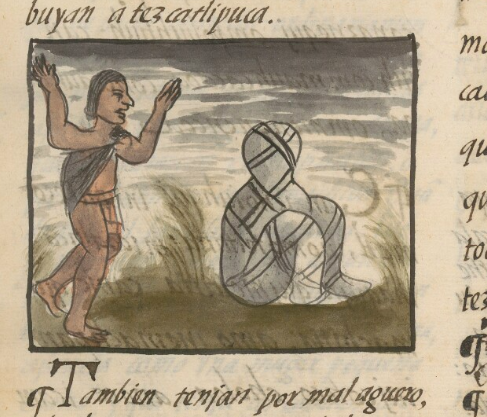micqui (FCbk5f13v)
This iconographic example features a deceased person (micqui). It is included here for the purpose of comparing it with glyphs for micqui and micquetl (two terms for referring to a deceased person, a dead body, corpse, or cadaver). This example shows what is likely a male person, given his sitting posture, with his knees up. He is entirely wrapped in a white cloth that is tied onto his corpse. This shrouded bundle sits on a green-brown ground, which shows European stylistic influence.
Stephanie Wood
In this collection, several glyphs of deceased persons (below) that are much like this (shrouded), and referred to as micqui, appear in glyphs from the Codex Mendoza. That codex also has nude bodies laid out, seemingly more inclined to be called micquetl than micqui.
Stephanie Wood
in micqui
in micqui
Stephanie Wood
1577
Jeff Haskett-Wood
muerto, muertos, cadáveres, cadáver, difunto, difuntos, cuerpo, cuerpos, la muerte
micqui, a deceased person, https://nahuatl.wired-humanities.org/content/micqui
el muerto
Stephanie Wood
Available at Digital Florentine Codex/Códice Florentino Digital, edited by Kim N. Richter and Alicia Maria Houtrouw, "Book 5: The Omens", fol. 13v, Getty Research Institute, 2023. https://florentinecodex.getty.edu/en/book/5/folio/13v/images/0 Accessed 30 June 2025.
Images of the digitized Florentine Codex are made available under the following Creative Commons license: CC BY-NC-ND (Attribution-NonCommercial-NoDerivs 4.0 International). For print-publication quality photos, please contact the Biblioteca Medicea Laurenziana ([email protected]). The Library of Congress has also published this manuscript, using the images of the World Digital Library copy. “The Library of Congress is unaware of any copyright or other restrictions in the World Digital Library Collection. Absent any such restrictions, these materials are free to use and reuse.”





